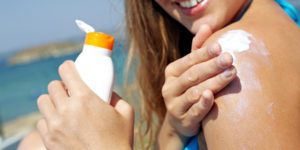
Everyone knows that the sun can burn your skin. The main culprit in sunlight is a high-energy radiation called ultraviolet (UV) light. There are two types: UV-A and UV-B. UV-B is the major cause of sunburn and increased skin cancer risk, while UV-A causes tanning and ageing of the skin, as well as to a higher skin cancer risk. The skin damage caused by UV radiation occurs mostly through a chemical process called photo-oxidation (as we’ve discussed before, here)
On an average summer weekend in Australia, 1 in 8 adults and 1 in 5 teenagers get sunburned while outdoors at the beach or pool, in the garden, or beside the barbecue. Perhaps unsurprisingly, Australia has one of the highest skin cancer rates in the world.
Sunburn causes 95% of melanomas, the most deadly form of skin cancer. It is the cause of other skin cancers too, such as basal-cell carcinoma (BCC) and squamous-cell carcinoma (SCC), that may be less life-threatening than melanoma but still dangerous if left untreated. All three types of skin cancer have become more common in the last 20-40 years, especially in areas with predominantly Caucasian populations like Australia.
The first-line in sun protection is to avoid sun exposure during periods of peak UV radiation (and most particularly during summer daylight hours). In Australia, the times of day when UV protection is recommended are published by the Bureau of Meteorology. On cooler and overcast days, many people mistakenly believe the UV radiation to be not as strong—but sunburn can still occur.
If you must be in the sun when the UV is high, then protect yourself:
Slip on sun-protective clothing that covers as much skin as possible.
Slop on sunscreen, and make it broad spectrum and at least SPF30+ (more on sunscreens below).
Slap on a hat with a broad brim (or legionnaire style) to protect your face, head, neck and ears.
Seek out the shade—don’t linger in the sun.
Slide on sunglasses, and make sure they meet Australian Standards for UV protection.
Sun exposure that doesn’t burn you can still damage your skin cells and increase your risk of skin cancer, especially when the exposure is regular, year after year. This is especially relevant to skin that is rarely covered (like the face, neck, or hands). Despite what many people think, having a sun-tan is not healthy.
A sunscreen, applied to at-risk skin, is the easiest way to protect against UV damage.
 There are two major types of active sunscreen ingredients:
There are two major types of active sunscreen ingredients:
How well a sunscreen can protect your skin is expressed as a SPF (sun protection factor) value. Oddly enough, an SPF value is determined by burning the skin of volunteers with a UV light. The SPF value is the ratio between the dose of UV light required to burn the volunteer’s sunscreen-protected skin over their unprotected skin. For a sunscreen to rate an SPF 50+ label, it must have a tested SPF of at least 60; that is, it took 60 times more administered UV light to burn skin that was protected by the sunscreen.
Sunscreen should be applied generously to clean dry skin, 20 minutes before UV exposure. Critically, it must be reapplied every two hours afterwards while in the sun. Try limit how long you spend in the sun during peak UV times. Sunscreens should never be used to extend the time you spend in the sun.
When buying a dedicated sunscreen product, look for an SPF of preferably 50+, as it will give you a more reliable, longer-lasting protection. If you are going to be in the water or perspiring heavily, choose a sunscreen that is water resistant. They are formulated in an oily cream vehicle that won’t easily wash off and leave you unprotected.
Protecting your skin against UV light with a broad-spectrum sunscreen not only reduces the risk of skin cancers, but also reduces UV-induced skin thickening, wrinkles, and visible signs of ageing.
Sunscreen ingredients get a lot of bad press, but the “risks” are exaggerated and overblown. People get scared reading websites and articles that declare sunscreens as containing endocrine disrupting chemicals, or nanoparticles of metal oxides. However, these “dangers” have never been shown scientifically, do not consider all the available evidence, or only occur in lab animals at doses many times higher than those used in sunscreens—doses many fold higher than could ever be absorbed through the skin.
One thing is certain: UV exposure is much, much more dangerous than any sunscreen.
People with sensitive skin can struggle to find a commercial sunscreen product that does not irritate their skin, however, and may come to believe the irritation is caused by the sunscreen ingredients. However, more often it is the sunscreen’s formulation—its base—that is the problem.
At Border Compounding Pharmacy, we have a range of metal oxide sunscreens (such as titanium dioxide) and UV-A and UV-B absorbing sunscreen ingredients available to create custom-made dedicated sunscreen products, or to add into your favourite BCP Custom Skincare product. Why not contact our friendly pharmacists to discuss your custom-made sunscreen needs today?
While we can’t put an SPF value on our products—that would require us to use your custom-made product on someone until they received a sunburn—we are confident that your skin will be well protected against incidental UV exposure. For prolonged exposure to sunlight, we recommend the use of a high-SPF, broad-spectrum primary sunscreen.
Why not also include an antioxidant like Milk thistle seed extract (silibinin) and/or Vitamin B3 (as scientists propose) to your sunscreen or skincare, to help recover from sun exposure?
Border Compounding Pharmacy products are unique, because they are formulated by pharmacists.
Comments will be approved before showing up.

